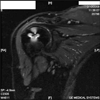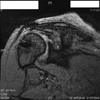Rotator cuff repair augmentation using a novel polycarbonate polyurethane patch: preliminary results at 12 months' follow-up
- PMID: 21106404
- PMCID: PMC3872973
- DOI: 10.1016/j.jse.2010.08.013
Rotator cuff repair augmentation using a novel polycarbonate polyurethane patch: preliminary results at 12 months' follow-up
Abstract
Background: Preventing anatomic failure after rotator cuff repair (RCR) remains a challenge. Augmentation with a surgical mesh may permanently reinforce the repair and decrease failure rates. The purpose of this study is to assess the postoperative outcomes of open RCR augmented with a novel reticulated polycarbonate polyurethane patch.
Materials and methods: Ten patients with supraspinatus tendon tears underwent open RCR augmented with a polycarbonate polyurethane patch secured in a 6-point fixation construct placed over the repaired tendon. Patients were evaluated with preoperative and postoperative outcome measures, including the Simple Shoulder Test, visual analog pain scale, American Shoulder and Elbow Surgeons shoulder score, Cumulative Activities of Daily Living score, and University of California, Los Angeles shoulder scale, as well as range of motion. Postoperative magnetic resonance imaging was used to evaluate repair status.
Results: Patients showed significant improvements in visual analog pain scale, Simple Shoulder Test, and American Shoulder and Elbow Surgeons shoulder scores at both 6 and 12 months postoperatively (P < .05 and P < .01, respectively). The University of California, Los Angeles postoperative score was good to excellent in 7 patients at 6 months and in 8 patients at 12 months. Range of motion in forward flexion, abduction, internal rotation, and external rotation was significantly improved at both 6 and 12 months postoperatively (P < .05 and P < .01, respectively). Magnetic resonance imaging at 12 months showed healing in 90%; one patient had a definitive persistent tear. We found no adverse events associated with the patch, including the absence of fibrosis, mechanical symptoms, or visible subacromial adhesions.
Discussion: The polycarbonate polyurethane patch was designed to support tissue in growth and enhance healing as shown by preclinical animal studies. Clinically, the patch is well tolerated and shows promising efficacy, with a 10% retear rate at the 12-month time point.
Published by Mosby, Inc.
Figures




References
-
- Adams JE, Zobitz ME, Reach JS, Jr, An KN, Steinmann SP. Rotator cuff repair using an acellular dermal matrix graft: an in vivo study in a canine model. Arthroscopy. 2006;22:700–709. - PubMed
-
- Aoki M, Miyamoto S, Okamura K, Yamashita T, Ikada Y, Matsuda S. Tensile properties and biological response of poly(L-lactic acid) felt graft: an experimental trial for rotator-cuff reconstruction. J Biomed Mater Res B Appl Biomater. 2004;71:252–259. - PubMed
-
- Badhe SP, Lawrence TM, Smith FD, Lunn PG. An assessment of porcine dermal xenograft as an augmentation graft in the treatment of extensive rotator cuff tears. J Shoulder Elbow Surg. 2008;17(Suppl):35S–39S. - PubMed
-
- Boileau P, Brassart N, Watkinson DJ, Carles M, Hatzidakis AM, Krishnan SG. Arthroscopic repair of full-thickness tears of the supraspinatus: does the tendon really heal? J Bone Joint Surg Am. 2005;87:1229–1240. - PubMed
-
- Bond JL, Dopirak RM, Higgins J, Burns J, Snyder SJ. Arthroscopic replacement of massive, irreparable rotator cuff tears using a Graft-Jacket allograft: technique and preliminary results. Arthroscopy. 2008;24:403.e1–409.e1. - PubMed
Publication types
MeSH terms
Substances
Grants and funding
LinkOut - more resources
Full Text Sources
Medical

